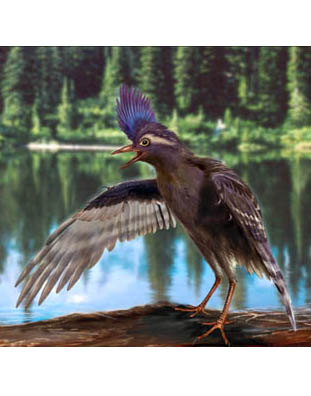 |
Feathered fossils from China reveal dawn of modern birds |
By Michael Balter
Put yourself on the planet 130 million years ago. Most of the animals, from horned dinosaurs to swimming, predatory plesiosaurs, would be deeply alien, not to say terrifying. But rising from the wetlands and winging across the sky were birds startlingly like today’s. That’s the message from t... |
|
 |
Scientists Discover Pigeon-size Dinosaur With Bat Wings |
| By Will Dunham, Reuters WASHINGTON - Scientists in China on Wednesday described one of the weirdest flying creatures ever discovered, a pigeon-size dinosaur with wings like a bat that lived not long before the first birds. The dinosaur, named Yi qi (meaning "strange wing" in Mandarin and pronounced EE-chee), lived a... |
|
 |
Bat-Winged Dinosaur Discovery Poses Flight Puzzle |
A newly described tiny creature has forelimb bones thought to support aerofoil membranes May 1, 2015 |By Sid Perkins and Nature magazine
A small, feathered dinosaur that probably sported bat-like wing membranes might have been able to glide or fly short distances. The fossilized remains of the creature, unearthe... |
|
 |
First 3D pterosaur eggs found with their parents |
This image depicts ecological reconstructions of Hamipterus. Credit: Chuang Zhao
Researchers have discovered the first three-dimensionally preserved pterosaur eggs in China. The eggs were found among dozens, if not hundreds, of pterosaur fossils, representing a new genus and species (Hamipterus tianshanensi... |
|
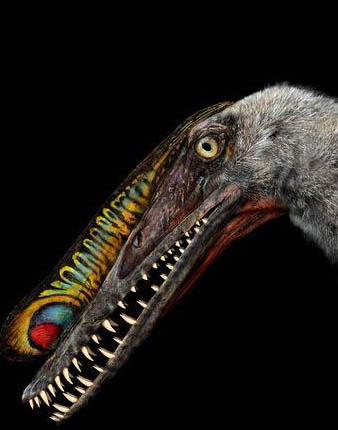 |
Stunning fossil eggs provide insight on ancient flying reptiles |
By By Will Dunham June 5, 2014 12:23 PM
An artist rendition depicts ecological reconstructions of Hamipterus, the flying reptiles that lived …
WASHINGTON (Reuters) - A spectacular fossil find in China - a prehistoric egg extravaganza from 120 million years ago - is providing unique insight into the lif... |
|
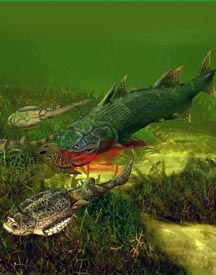 |
IVPP scientists receive 2013 State Natural Science Award of China |
IVPP scientists were conferred a second-class award of the 2013 State Natural Science Award (SNSA) in recognition of their achievements in the project “Studies on Origin and Early Evolution of Osteichthyes”. The award presentation ceremony was held today (January 10) in Beijing.
Osteichthyes, known as the bony... |
|
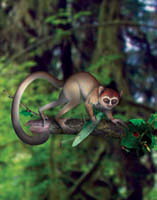 |
IVPP’s Study Selected as One of Discover’s Top 100 Stories of 2013 |
| One research discovery from Institute of Vertebrate Paleontology and Paleoanthropology (IVPP), Chinese Academy of Sciences, "The oldest known primate skeleton and early haplorhine evolution", developed by Dr. Xijun Ni, and his collaborators from USA and France, was honored as the 48th of this year's top 100 science ... |
|
 |
Nature:Hominin DNA baffles experts |
By Ewen Callaway 04 December 2013
Location of the Middle Pleistocene site of Sima de los Huesos (yellow) as well as Late Pleistocene sites that have yielded Neanderthal DNA (red) and Denisovan DNA (blue).
Another ancient genome, another mystery. DNA gleaned from a 400,000-year-old femur from Spain has reveal... |
|
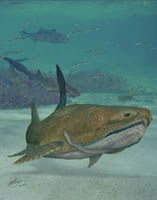 |
Nature:Ancient fish face shows roots of modern jaw |
Primitive vertebrate's sophisticated mandible rewrites evolutionary tree.
Eliot Barford 25 September 2013
The newly described armoured fish showed in this reconstruction lived 419 million years ago but already had the bony jaw seen in modern fish and most other vertebrates. Brian Cho
It may be hard to s... |
|
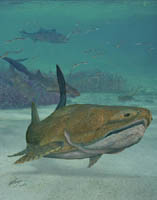 |
The Conversation:Extraordinary ‘missing link’ fossil fish found in China |
Finding Entelognathus is a revelation comparable to the discovery of Archaeopteryx. Brian Choo
A spectacular new “missing link” fossil has been unearthed in China. The 419 million year old armoured fish, called Entelognathus, meaning “complete jaw” solves an age-old debate in science. For palaeontologis... |
|









